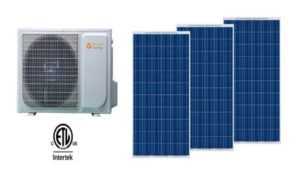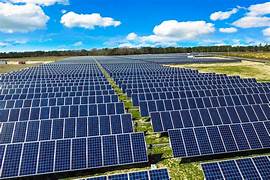Solar Air-Conditioning
Project Description:
Solar Air-Conditioning powered by solar energy has great potential, in part because high demand for coolingusually, coincides with plentiful sunlight.
The DC4812VRF is designed from the ground up to operate on DC power. There is no AC power used inside or needed externally to operate the unit. DC power is connected to the outdoor unit. The indoor unit receives DC power from the outdoor unit.
The intensity of solar energy on the roof of a typical single -story building in India is roughly ten times the cooling requirement for the same building. At an economically competitive level could reduce electricity costs for residential and small commercial customers. This would cut the growth of peak electric demand and ease the increasing pressures on generating capacity, transmission, and distribution. Currently available technologies are neither practical nor cost-effective. Photovoltaic (PV) systems require a large roof area and cost many times more than a conventional air conditioner. Thermally driven absorption cooling requires costly, high-temperature collectors and undesirable cooling towers. Furthermore, these systems have a disconnect of several hours between peak cooling capacity and peak cooling demand. That, in turn, requires electric or thermal storage in order to maximize the solar contribution.
Battery
• 48v Solar/Battery Power
• Cool or Heat up to 700 ft^2
• Variable Capacity
• Anti-Corrosion Technology
• Eco-Friendly R410a Refrigerant
• Washable Filters
• Digital Wireless Remote
• Quiet Indoor Unit
A system employing relatively inexpensive low-temperature collectors, coupled with an innovative desiccant dehumidification and evaporative process, provides a new prospect for cost-effective solar cooling. If proven practical and economical, the savings potential in the India market for rooftop air conditioning would be 8.5 billion kilowatt hours (kWh) in energy and $1 billion per year. This corresponds to a reduction in electric demand in India of 5,500 megawatts (MW). The potential nitrogen oxides (NOx) reduction in India is 2,400 tons annually, based on the state average 2000 annual NOx output emission rate of 0.564 pounds per megawatt hour (lb/MWh).
The research concept couples modest-cost, low-temperature collectors with a low-cost DC concept solution for desiccant dehumidification and thermal storage. The addition of an compressor produces air conditioning at a competitive cost. The economic viability of this concept depends on optimizing the system and its components and on developing two key innovations—a low-cost heat exchanger and ac
solar thermal desiccant-regeneration subsystem
Proposed Outcomes:
Actual Outcomes:
1. Nine different designs of low-cost, liquid-to-liquid heat exchangers were evaluated; two were tested. The preferred configuration consisted of plastic sheets welded together to form two counter-flow channels. It was the easiest to assemble and achieved a heat-transfer coefficient of 40 BTU/hr/ft2/ °F, but the development of small circuit-to-circuit leaks prevented lengthy and repeatable testing.
2. Sample solar-collector tests measured the evaporation rate from a calcium chloride solution. The sample collector consisted of a plastic plate filled with calcium chloride solution and covered with a black polyethylene film. The measured evaporation rates ranged between 0.5 and 1.0 lbm/day/ft2 under partly cloudy summer conditions in Northern Virginia.
3. The estimated cost per ton was based on modeled subsystem sizes and projected costs for materials, factory labor, mark-up, freight, and installation. The total projected price to an end user was $1,825 per ton. Electricity requirements are expected to be on the order of 0.25 kilowatts per ton(kW/ton), about 1⁄4 that of a high-efficiency electric rooftop package. Annual water usage is estimated at 6,000 gallons per ton for a typical India application.
Conclusions:
1. Low-temperature solar collectors can provide effective regeneration of a calcium chloride liquid desiccant solution. Average evaporation rates of 0.5 to 1.0 lbm/ft 2/day are achievable in India with simple open-collector designs.
2. A low-cost, high-performance, liquid-to-liquid heat exchanger was tested with an overall heat-
transfer coefficient in the range of 40 BTU/hr/ft 2/ °F. Leak-proof construction and longevity are important areas for future attention.
3. A projected 75% reduction in electricity use for air conditioning corresponds to an electric Coefficient of Performance (COP) equivalent of 14. By contrast, a high-efficiency rooftop package has a COP of 3.5.
4. Water requirements appear to be modest and do not add appreciably to the operating expenses.At $3/1,000 gallons, the cost for water is $18/ton/yr, a fraction of the cost for an electric air conditioning evaporator unit. If the entire India inventory of rooftop air conditioning switched to this approach, the annual water requirements would be 100,000 acre-feet. In contrast, India consumes 9.5 million acre-feet annually for urban uses.5. Modeling, coupled with preliminary cost estimates for materials, labor, markups, and installation, indicates that the solar air -conditioning system has the potential to achieve installed costs of $2,000/ton, on par with the typical installed cost of efficient rooftop models.
5. Modeling, coupled with preliminary cost estimates for materials, labor, markups, and installation, indicates that the solar air -conditioning system has the potential to achieve installed costs of $2,000/ton, on par with the typical installed cost of efficient rooftop models.
The technical feasibility of a novel solar air conditioner incorporating low-cost materials has been proved. Simple heat and mass-transfer tests were performed with representative material samples. The measured properties were used to size and cost the system. Beyond the scope of this small grant, considerable work remains to scale up the subsystems; to test pr ototype systems for performance and durability in an outdoor environment; and to confirm cost estimates for manufacturing,distribution, and installation.
Benefits to India:
The primary benefit to the ratepayer from this research is increased the affordability of electricity in India. The novel solar-air-conditioning concept would reduce the biggest cause of peak electricity demand. That would enable increased utilization of the generation, transmission, and distribution system and would delay new generating and transmission investments, lowering the cost of delivered electricity. Reducing peak demand also helps relieve congestion and improves the reliability of the power supply.
An economic solar air conditioner would also help India adopters of the technology control their energy expenses. The light commercial and small industrial sectors would best be able to utilize this technology. The electricity usage for rooftop air conditioning in India is 11.4 billion kWh per year. With energy savings of 75% projected, the displacement potential of solar air conditioning in these India sectors is estimated at 8.5 billion kWh annually. That corresponds to a demand reduction in the vicinity of 5.5 GW and a consumer cost savings of $1 billion per year.
Recommendations:
The solar air-conditioning concept is a novel approach that recognizes the importance of initial cost to economic viability and market acceptance. Although the scale-up of the concept, its durability, and its true cost remain uncertain, it merits funding for the next development step. Further work should address the following:
· Heat-exchanger design and fabrication techniques for low cost and high performance.
· Heat-exchanger material that is inexpensive yet durable for ten to fifteen years of operation.
· Collector subsystem design that meets the $70/ton material cost target yet is rugged enough to endure ten years of outdoor operation.
· Bench-scale system test to verify cooling capacity and parasitic electricity requirements.
· Following additional research and laboratory prototype testing, verification of the $2,000 -per-
ton installed target requires in-depth analysis of material, manufacturing, distribution, sales,and installation costs.
Inclusion :-
Panel Structure :- Not included in this kit .Cost extra or build yourself by local Iron vendors.
KIT Wiring :- Included.
Installation :- Included.
Solar AC Cost : – 1ton AC : One Lakh. 1.5 Ton AC : 1Lakh 50000 2 Ton AC :- 2 Lakh. Overall estimation : 1lakh per ton.
Guarnatee & Warranty:- Covered by Std Manufacturer.
Panel :25Years diffrential warranty.
Controller :-2 Year.
AC : 1 Year by Manufacturer.(Daikin/ LG / Samsung etc)
This project concept is a part of the research portfolio of the India Energy Commission. The Energy Commission supports energy research and development that improves the quality of life in India by bringing environmentally sound, safe, reliable, and affordable energy services and products to the
marketplace.






